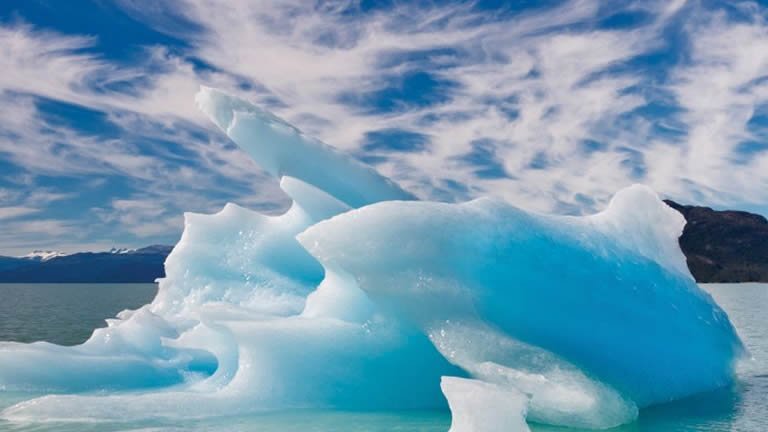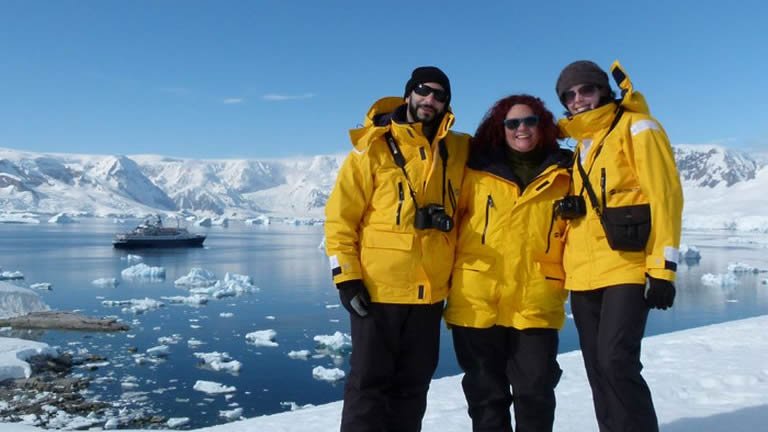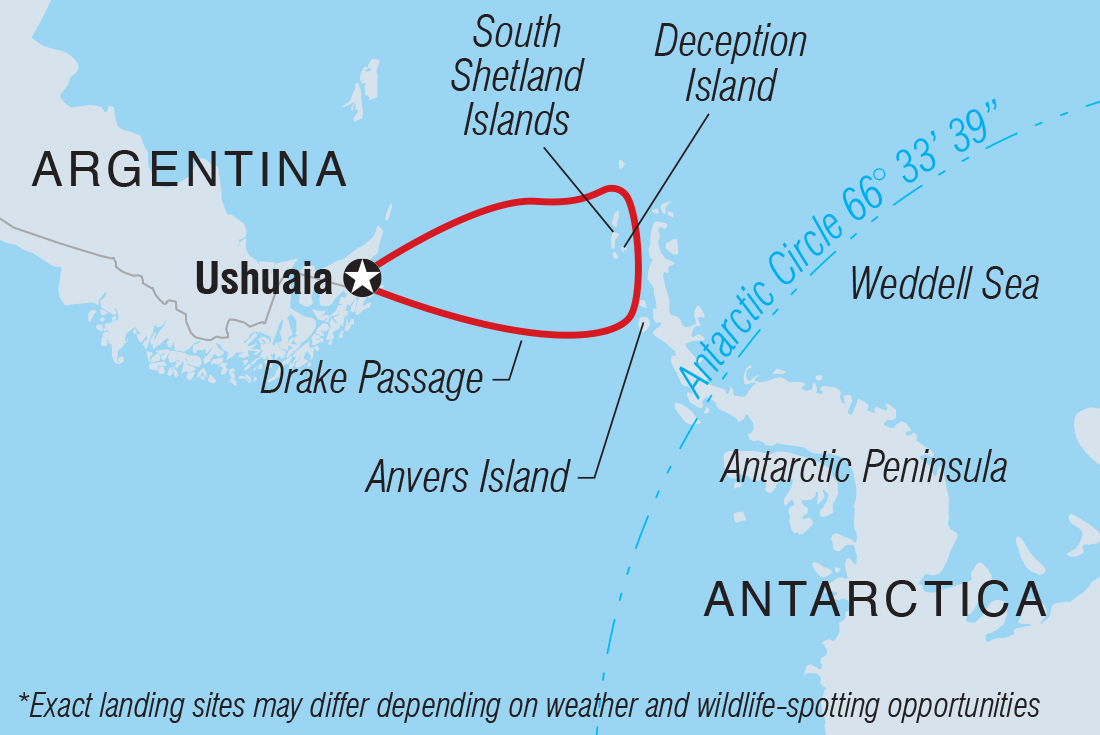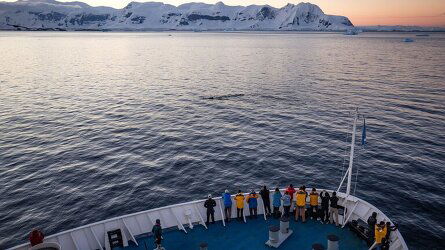Trip Style
Comfort
Max. Group Size
127
Pace
Easy
Trip Code
GQWWF
Overview
Book online and enjoy exclusive savings on Intrepid's 11 Day WWF Giants of Antarctica. Join Intrepid and special guests from the World Wildlife Fund – Australia (WWF-Australia) on an 11-day expedition to the Antarctic Peninsula. Scout icy waters and white shores for whales and other critters by day, then relax and enjoy a fascinating lecture program by night. Alongside our regular team of Antarctic experts, WWF-Australia scientists will join this tour to share insights into whale conservation as they conduct cutting edge research on these underwater giants.
While sailing on the Ocean...read more Endeavour and exploring by Zodiac, scan the icy waters for the silhouettes of these mighty marine mammals as they glide through ice floes or break the Antarctic silence with spectacular acrobatics. Step foot on the Great White Continent to watch curious penguins, basking seals and many fascinating seabirds on a journey you’ll never forget.
While sailing on the Ocean...read more Endeavour and exploring by Zodiac, scan the icy waters for the silhouettes of these mighty marine mammals as they glide through ice floes or break the Antarctic silence with spectacular acrobatics. Step foot on the Great White Continent to watch curious penguins, basking seals and many fascinating seabirds on a journey you’ll never forget.
Itinerary
Welcome to Ushuaia, the gateway to Antarctica. Take your included transfer from the airport to your hotel. Tonight, you’ll meet your fellow travellers and your local team in Ushuaia during a welcome briefing at your hotel. If you have some time to spare before the meeting, maybe head downtown to do some souvenir shopping or taste some classic Argentinian flavours at one of Ushuaia's fantastic local restaurants.
This morning is yours to explore Ushuaia or the Tierra del Fuego National Park, the most southerly national park in South America. Tierra del Fuego National Park offers a range of hiking trails that lead you through the stunningly beautiful and dramatic scenery of snow-capped peaks, lush meadows, rugged coastline, glaciers, waterfalls and lakes. Look out for guanaco, Andean foxes, muskrats and the North American beaver. Birds found here include the Andean condor, Magellanic oystercatcher, kelp goose, austral parakeet, and torrent duck. In the afternoon, transfer to the port of Ushuaia to embark the Ocean Endeavour, your home on the sea during your Antarctic adventure. After meeting your fellow passengers and Expedition Team and settling into your cabin, set sail through the historic Beagle Channel towards Antarctica. Travelling with you on this voyage is a small team of WWF-Australia scientists, who are heading to Antarctica to undertake crucial research on the migration and feeding patterns of baleen whales. Soak up the incredible views as you glimpse your last sight of Argentina, then head inside to join the excitement and learn more about what’s to come over the coming days. (B/D)
Spend two days travelling across the legendary waters of the Drake Passage, named after the British seafarer Sir Francis Drake, towards the Antarctic Peninsula and the South Shetland Islands. If conditions allow, there will be a chance to enjoy the outer deck spaces, scouting for dolphins, whales and a variety of seabirds passing by, including the iconic wandering albatross, with its enormous three-meter wingspan. As well as safety briefings, a comprehensive lecture program will run throughout the journey delivered by experts in Antarctica’s history, geology and biology, as well as WWF’s team of researchers. If the weather is on your side, you should reach the Islands of the Antarctic Peninsula by early evening on day four – the first sighting of land always builds great anticipation on any expedition south. (Bx2/Lx2/Dx2)
The Antarctic Peninsula is known for a high number of wildlife sightings in front of stunning backdrops of mountains, icy landscapes and water, which combine to provide incredible scenes as you search for whales migrating along the coast.
The peak of the migration season (February and March) is the best opportunity to see these majestic ocean dwellers, as all Antarctic whale species migrate long distances, feeding in the cold, nutrient-rich Southern Ocean during the southern summer. The most common species found in the region are humpback, minke and fin whales, as well as orcas. As whale season is in full swing, keep your eyes peeled as you head out on daily Zodiac excursions.
The WWF research team travelling with you will take another Zodiac to search of whales, deploying non-invasive tracking tools to gather data such as whale orientation, movement and speed. The suction-capped devices used also have two cameras attached, providing a first person (or first-whale!) view of underwater lives. The researchers will also use drone technology to track whale size and movement from above, as well as to observe krill populations in the southern oceans. While they may be exploring in different regions to you on any given day, they will report back regularly at the evening recap presentations.
You can be a scientist, too! Join one of the exciting on board citizen science projects, the Happy Whale Project, where you can upload photos of whale’s tails (flukes) online, along with details of where the images are taken, which are then used to analyse and identify the individual whale and track its movement across the oceans. Sightings can happen from the outer decks of the ship or during a Zodiac excursion, or on the ship's bridge with your captain, where the open bridge policy allows you into the command centre of the Ocean Endeavour for a look at the inner workings of your expedition and access to the best place to spot whales.
An average day on board begins with a wake-up call from your expedition leader around 7 am, giving you time to prepare for the day before joining your fellow expeditioners for breakfast in the Polaris restaurant. You will usually have two excursions per day, one in the morning and one in the afternoon, with a delicious lunch served on the Ocean Endeavour in between. (Bx4/Lx4/Dx4)
The peak of the migration season (February and March) is the best opportunity to see these majestic ocean dwellers, as all Antarctic whale species migrate long distances, feeding in the cold, nutrient-rich Southern Ocean during the southern summer. The most common species found in the region are humpback, minke and fin whales, as well as orcas. As whale season is in full swing, keep your eyes peeled as you head out on daily Zodiac excursions.
The WWF research team travelling with you will take another Zodiac to search of whales, deploying non-invasive tracking tools to gather data such as whale orientation, movement and speed. The suction-capped devices used also have two cameras attached, providing a first person (or first-whale!) view of underwater lives. The researchers will also use drone technology to track whale size and movement from above, as well as to observe krill populations in the southern oceans. While they may be exploring in different regions to you on any given day, they will report back regularly at the evening recap presentations.
You can be a scientist, too! Join one of the exciting on board citizen science projects, the Happy Whale Project, where you can upload photos of whale’s tails (flukes) online, along with details of where the images are taken, which are then used to analyse and identify the individual whale and track its movement across the oceans. Sightings can happen from the outer decks of the ship or during a Zodiac excursion, or on the ship's bridge with your captain, where the open bridge policy allows you into the command centre of the Ocean Endeavour for a look at the inner workings of your expedition and access to the best place to spot whales.
An average day on board begins with a wake-up call from your expedition leader around 7 am, giving you time to prepare for the day before joining your fellow expeditioners for breakfast in the Polaris restaurant. You will usually have two excursions per day, one in the morning and one in the afternoon, with a delicious lunch served on the Ocean Endeavour in between. (Bx4/Lx4/Dx4)
As the Ocean Endeavour starts its return journey north to your home port of Ushuaia, now is your time to reflect on your amazing journey. Take the opportunity to speak with the WWF-Australia team about their whale research findings from their time on the Peninsula. Ultimately, the team hopes that their research will lead to the establishment of an Antarctic marine protection area, preventing krill fishing in the region and safeguarding the health of baleen whales. The Intrepid Foundation helps facilitate this research voyage and supports WWF-Australia’s Protecting Antarctic Giants project. You’re scheduled to reach the relatively calm waters of the Beagle Channel by the evening of day 10. This evening, your final meal together in the Polaris restaurant is often a highlight of our Antarctic adventurers, so live it up and enjoy as you celebrate an incredible adventure with your fellow travellers and expedition team. (Bx2/Lx2/Dx2)
Disembark the Ocean Endeavour after breakfast as your Antarctic expedition comes to an end and the memories of an amazing adventure begin. A morning transfer to Ushuaia airport is included if you are departing today. (B)
Trip Inclusions
- Be joined by a team of naturalists, marine biologists and WWF-Australia scientists and learn how they're conducting cutting-edge research into Antarctica’s great whales with onboard lectures and interactive experiences.
- Witness an incredible abundance of humpback whales as these serene marine mammals migrate to Antarctica to feed on krill each year. If conditions allow, take Zodiac excursions to get closer to whales spotted by your expert expedition crew.
- Get the chance to encounter a range of other wildlife like gentoo and chinstrap penguins, fur and elephant seals, albatross and more.
- Expeditions on the Ocean Endeavour enjoy an enviable ratio of one expedition crew member for every eight passengers, allowing for a higher level of personal service.
- Benefit from a variety of on-board activities including educational lectures on history, geology, and ecology by the expedition team and enjoy the amenities on board including expedition lounge, restaurant, bar, pool, jacuzzi, library, gym, sun deck, spa facilities and sauna.
- By travelling on this trip, you’ll directly support our Intrepid Foundation partner, WWF-Australia. Donations support their pioneering whale research and conservation efforts to establish marine protected areas around Antarctica.
- 1 night comfortable hotel
- 9 nights expedition cruise ship
- 10 Breakfasts included
- 8 Lunches included
- 9 Dinners included
- Accommodation, itinerary and inclusions subject to change.
- Price is for land, cruise and internal flights as specified. Flights not specified are not included

Brochure

Intrepid Antarctica & The Arctic (2022-24)
We don’t believe in travel as simply a way to tick items off a bucket list. We take the time to get under the skin of a destination and discover what makes it unique. Of course, we all want to see a polar bear in the Arctic or king penguins on South Georgia Island, but while we’re there we’ll spend time with the Inuit people and learn about their way...more of life, or cruise around in Zodiacs to gaze at the monolithic icebergs up close. Seeing the famous landmarks and wildlife is a must, but experiencing them with a passionate expert is what makes these trips truly special.
Prices & Dates
There are currently no departures available on this trip. Either it's the end of the season and new departures will be released shortly, or this itinerary has been changed and will no longer continue. Feel free to contact us for information about when next seasons dates will be released or click here to view the general release dates for all destinations.
Note
Tour & cruises prices are per person. Prices shown have savings applied, are subject to availability and may be withdrawn at any time without notice. Prices and trip information are correct at the time at this point in time, however are subject to confirmation at the time of booking and are subject to change by Intrepid. For cruise itineraries, cabin images are sourced from Intrepid. These should be treated as indicative only. Cabin inclusions, upholsteries and room layout may differ to the image(s) shown depending on the ship selected and your sailing dates.
Tour & cruises prices are per person. Prices shown have savings applied, are subject to availability and may be withdrawn at any time without notice. Prices and trip information are correct at the time at this point in time, however are subject to confirmation at the time of booking and are subject to change by Intrepid. For cruise itineraries, cabin images are sourced from Intrepid. These should be treated as indicative only. Cabin inclusions, upholsteries and room layout may differ to the image(s) shown depending on the ship selected and your sailing dates.









